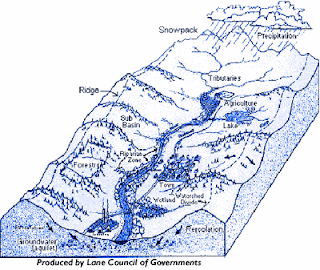A.) The Water Cycle
The ware on Earth is always moving. The natural water cycle, also known as the hydrologic cycle, describes this movement of water on, above, and below Earth’s surface. Water can change between liquid, vapor, and ice. These processes have been happening in the blink of an eye for over millions of years.
Water Cycle; http://ga.water.usgs.gov/edu/watercycle.html
Why Evaporation/Condensation occurs:
Heat energy is need for evaporation to occur. Energy is used to break the bonds that hold water molecules together. Net evaporation occurs when the rate of evaporation exceeds the rate of condensation. Condensation occurs when saturated air is cooled below the dew point.
Precipitation and Transpiration:
Precipitation is water that is released from clouds in the sky. Precipitation can come in the form of rain, freezing rain, sleet, snow, or hail. It’s is the primary source in the water cycle that provides the delivery of water the Earth. Transpiration is the passage of water from a plants roots and leaves into the atmosphere. The more temperature rises, the higher chance transpiration will occur.
Infiltration and Groundwater/Aquifers:
Infiltration is the seepage of water into soil or rock.6 Some of the water that infiltrates will remain in the shallow soil layer, where it will move through the soil. Some water may infiltrate deeper, recharging groundwater aquifers. Aquifers are a good way to store groundwater, which is fresh, drinkable water. People can drill wells into these aquifers and use this water for whatever purpose they desire.
Surface runoff:
Surface runoff is the water flow that occurs when soil is infiltrated to full capacity and excess water from rain or other sources that flow over the land. When runoff flows along the ground, the water can pick up contaminants of the soil like pesticides or fertilizers. 1
B.) What is a Watershed?
A watershed is an area of land where all the water that is under it or drains off of it goes into the same place. In the words of John Wesley Powell, a scientist geographer, a Watershed is:
"that area of land, a bounded hydrologic system, within which all living things are inextricably linked by their common water course and where, as humans settled, simple logic demanded that they become part of a community." 2
Watersheds are also known as ‘drainage basins’. A drainage basin is an area of land where surface water from rain and melting snow or ice comes to a single point, usually the exit of the basin, where the waters join another water body,
C.) Rivers
There are 3 types of rivers: Whitewater, black water, and Clearwater
there are rapids or water turbulence present. There is a classification system from Whitewater Rivers based
on difficulty and danger; they are rated on a scale from I-VI. (1-7) Class I is usually water that is very still
and calm and has few obstructions, while class VI has no visibility (when rafting), very dangerous waters,
and many obstructions. (When rafting, this class of Whitewater River
A Black water river is a deep, slow-moving river that runs through swamps and wetlands. White water and
black water differs mainly in ionic compounds. Black waters are more acidic due to vegetation decay.
They also differ in sodium, magnesium, and calcium levels. 5
Clearwater Rivers are named for their clear, clean waters. Because of their elevation, they tend to run
over rocks. Because of the clarity of the water, these rivers tend to have plant growth such as algae in them. 4
All these rivers move and were created by the movement of the Earth’s runoff. Most rivers run
downhill or towards another larger river or an ocean. The flow of the river is determined by the Earth’s
crust and the plant growth, animals and other things around it.
Bibliography:
Howard Perlman; U.S. Geological survey; U.S. Department of the Interior. (2011)
Hydrologic Unit Geography; Virginia Department
Rhett Butler; Mongabay.com. (2009)
Comparison between Black and White waters; Amazonian Fishes and their Habitats. (2006)



No comments:
Post a Comment